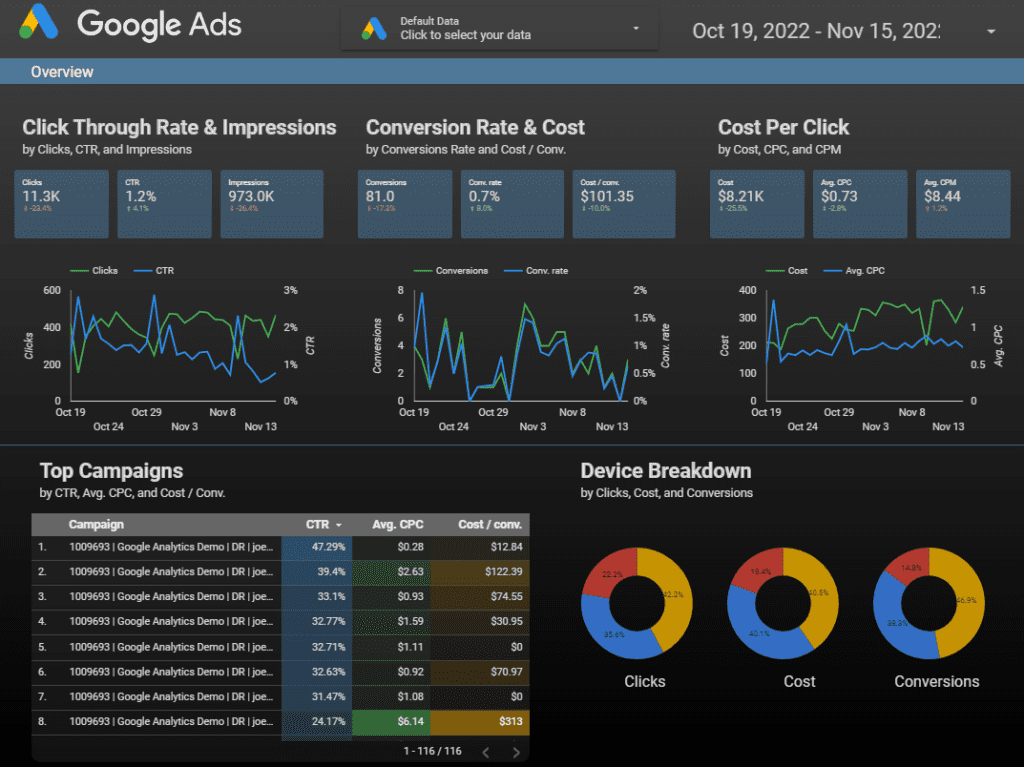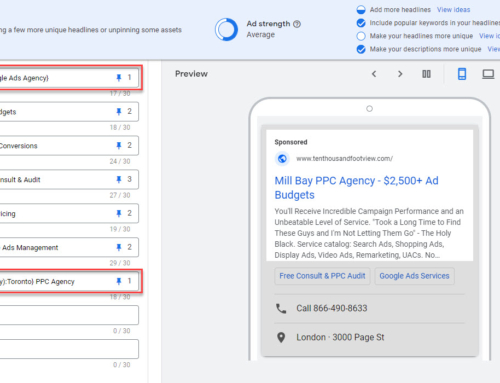If you’re a PPC manager that’s feeling a time crunch this post is for you. I’m going to highlight the 10 biggest Google Ads time savers. Implementing these will free you up to spend more time working on PPC strategy, other marketing tasks, or watching more “Cheers” reruns, it’s entirely up to you.
1. Automate Reporting
This is a no-brainer once you have 5 or more accounts/reports to work with. Exporting campaign data into spreadsheets or even using the Google Ads report builder to generate reports every week or month is a huge time waster. Consider using Data Looker Studio or a 3rd party reporting tool like Swydo to automatically produce your reports on demand.
These systems can also work as dashboards so you and your stakeholders can have 24/7 access to your most important KPIs. Many of our agency clients love this feature and don’t have to bother us to access their numbers.
2. Rightsize Your Ads Account
It’s no longer 2019, time to ditch the SKAGs! Running overly complex campaigns, too many keywords and ads, or splitting a relatively small budget among a bunch of campaigns is inefficient and ineffective. Simplifying your account to push more conversions through fewer entities will help you and built-in automation optimize faster and better. And if you cut 50% of your campaigns, guess what, you’re also cutting 50% of the time you spend on campaign reporting, analysis and adjustments.
3. Use Offline Editors for Major Updates
I duplicated a relatively simple search campaign online yesterday and waited for a full 5-minutes for Google to finally spit out a result! That’s unusual, but I literally took a coffee break while I waited.
If you have a big campaign build or revision to do you should consider taking it offline with Google or MS Editor. First, these tools don’t lag like web interfaces so you won’t get bogged down waiting for screen reloads. Second, you can very quickly replicate campaigns, ad groups, ads, locations, and other campaign entities that take ages to process online.
In addition, you can copy/paste a lot of entities that aren’t possible via the browser.
For example, do you have 100 radius-based locations targeted in campaign A that need to be copied to campaign B? You know you can’t just copy/paste those online, right? With the Editor, you can easily do so in seconds. Likewise, you can block all app placement types in seconds via the Google Editor vs. spending 5 minutes and getting writers cramp doing it online.
4. Run Automated Bidding
Unless you’re working with very low conversion volume you should be using conversion-based automated bidding… and I don’t mean ECPC! A fully automated bidding option will free you up from individually adjusting keyword bids as well as maintaining bid adjustments across unique audiences, locations, ad schedules, devices, and more.
Manual bid management is one of the most time-consuming tasks and should be practically eliminated in all but the smallest accounts. Not sure which bidding option to use? check out our blog post all about bidding strategies.
5. Use Monitoring Scripts & Tools
We use both custom and 3rd party monitoring scripts extensively at our agency. Our main “dashboard” script eliminates the need to log into accounts every day to perform a sanity check. At a glance, we can see all of our client accounts and activity per day, week, and month along with any anomalies. This makes it dead simple to quickly troubleshoot issues like expired credit cards, suspended accounts, budget overruns, conversion dropoffs and more.
Another great script we use checks our client merchant accounts for disapproved products. Since Google doesn’t provide default notices for this the workaround is a way to automatically receive an email warning if your disapproved products climb above your preset threshold.
We also use Pingdom, to monitor client landing pages. If a page goes down for any reason we will know about it in a few minutes, can pause campaigns and notify the client.
It’s time to free yourself from logging into your accounts every day.
6. Split Test With Ad Variations
Instead of manually testing individual ad copies in multiple RSAs try testing at scale with ad variations. This testing method will allow you to test different headlines, descriptions, and landing pages across a large group of ads at scale. More importantly, Google will automatically report on the statistical significance of your test. And, you can adopt winning ad variations with a button click.
Best of all, you will have a neatly organized history of the variations you’ve tested, the results for each, and which you’ve implemented.
7. Use Automated Rules
Automated rules come in very handy for scheduling routine tasks you otherwise manually perform on a schedule. The simplest examples are executing campaign launch and completion dates or activating/deactivating creatives.
While you can set start/end dates when you create a campaign, you can only do that once. Often you might keep an evergreen “sales” campaign around and modify it for your next upcoming sale. An automated rule allows you to activate and pause the campaign exactly when needed. Likewise, you can pause your “standard” search campaign while you’re running this one.
As for the trick with creatives, you can toggle different RSAs off/on whenever you’re running a sale. Taking the sale angle one step further you could also pause seasonal keywords like “black Friday” when your sale ends to prevent paying for visitors that won’t convert.
It’s worth playing around with custom rules to see what’s possible, you may save yourself hours every month.
8. Try PPC Management Software
If you’ve got more hands-on PPC work than you can handle it may be worth looking at a PPC management suite. Good solutions can take automation to the next level by facilitating campaign builds on auto-pilot, updating bid adjustments when using manual bidding, assisting with negative keyword strategy, and setting value-based adjustments on autopilot.
Many of these tools also take care of reporting and monitoring so you don’t need separate solutions for those. As for options, there are many to choose from. We’ve included the products we like in our free Best 100 PPC Tools eBook.
9. Use List-Based Exclusions and Negatives
If you’re running campaigns across several accounts you should be maintaining default placement exclusion and negative keyword lists. Applying these to your top-level manager account will give you a headstart on filtering garbage queries and placements from the get-go.
Typically search queries like “job” and “free” are unwanted by most advertisers. But be careful with this and always review the applicability for each new account. While it’s a little more work, we maintain our lists outside of Google Ads and apply them per account as appropriate. However, this brings with it the issue of version control. Since we’ve been doing this for several years we, fortunately, don’t need to update master negative keyword lists very often.
Things are a little more simplistic with placements. A bad placement for one advertiser is almost always going to be bad for another advertiser. Using a manager account level list is the way to go here.
10. Create a Standard Operating Procedure
Developing a consistent process you follow for creating and optimizing campaigns will save you countless hours of work.
Having such a standard will ensure you don’t miss anything that could lead to poor performance. Likewise, it’ll help you avoid repeating tasks too frequently. And, if you work within a team, campaign design will be consistent and easy to manage across all of your accounts.
Taking our own client onboarding process as an example, we’ve cut about 30% of the time it takes to take care of back-office setup.
Summary
I hope you find these Google Ads time savers useful for your own business or agency. Know another great time saver, please post it in the comments.






